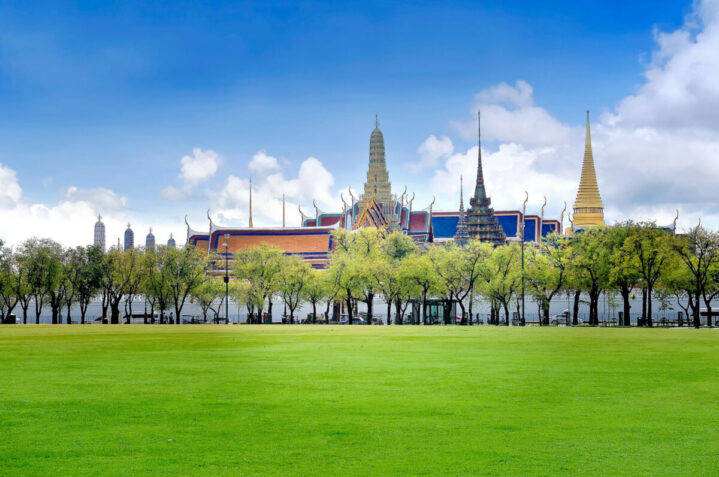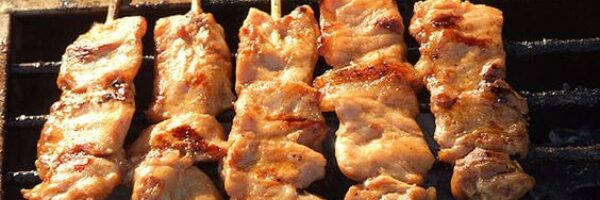
Royal Turf: Sanam Luang
Of all the major or important sights in Bangkok that have changed the least, then Sanam Luang (Thai: สนามหลวง, or literally “royal turf”) is most likely at the top of the list. The spacious grounds has served a multitude of official and unofficial functions for almost two and a half centuries. The royal field is an important part of modern Thai history and its national culture having had so many important events and rituals held in the public park.
Sanam Luang was laid out during the construction of the Grand Palace complex in 1782, when the capital was moved from the Thon Buri side of the Chao Phaya River to Bangkok. Sanam Luang now measures 74.5 rai, 119,200m2 or almost 30 acres. It is considered both an open field and public square. Officially, Sanam Luang is known as “Thung Phra Men” or (the royal cremation ground; Thai: ทุ่งพระเมรุ). It has also been referred to as the Royal Park, the Royal Field and the Royal Grounds for the many royal or official ceremonies held there. It is a public square situated right in front of the Grand Palace. Sanam Luang has been frequently used as a site for the cremation of royal family members, including many of Thailand’s kings, queens, royal princes and princesses plus other nobility since the reign of King Rama I.
The first royal cremation at Sanam Luang was King Rama I’s brother, the vice-king or prince-successor, who occupied the Front Palace, a royal residence nearby the Grand Palace. King Rama II followed this tradition by both performing royal ceremonies at Sanam Luang and conducting the cremation rites of his closest brother, also a vice-king or prince-successor. During King Rama III’s reign, Thailand entered into a dispute with Vietnam over Cambodia’s border demarcation. Since “farangs” were starting to return to Thailand at this time, the king wanted to demonstrate to them, and all other nations, that his country was a flourishing, prosperous nation. So Sanam Luang was converted into a rice field. Even the grounds in front of the Grand Palace were placed into rice cultivation. When the grounds were needed for a royal funeral, Sanam Luang was covered over with dirt for the cremation ceremony. There was a barn nearby to store the rice husks.
In 1855, King Mongkut (King Rama IV) changed its name from “Thung Phra Men” to “Thong Sanam Luang”. The name was later shortened to “Sanam Luang” and is now of common usage. King Mongkut also established Sanam Luang as the site for the ancient ritual, the Royal Ploughing Ceremony. Low walls were placed on the grounds and a small pavilion was erected to house a Buddha statue for the ceremony. There were other pavilions and towers placed on the grounds including one for the king so he could watch the ceremony. Next to the king’s pavilion a stage was erected so plays could be performed as part of the ploughing ceremony to appear the ancient spirits.
King Chulalongkorn (King Rama V) enlarged the grounds. He also ordered all the old buildings dismantled that had been previously used. Rice growing was discontinued as the space was needed for Bangkok’s centennial celebration in 1897 when King Rama V returned from his European tour. He also ordered two rows of tamarind trees to be planted that encircled the park. By 1900 Sanam Luang was the site of Bangkok’s first golf course and race course. This was due to more foreign visitors and residents. In a July 1901 local newspaper article it mentioned that “farangs” doing snipe hunting in the park. Kite flying has always been a popular sport there.
King Vajiravudh (King Rama VI) continued his predecessors use of Sanam Luang for conducting various ceremonies. King Bhumibol Adulyadej (King Rama IX) also sponsored the Royal Ploughing Ceremony each May. Other celebrations conducted during his reign were the 1982 bicentennial celebration of Bangkok’s founding and the grand celebration of the King’s golden jubilee in 1996. Royal cremations included those for King Ananda Mahidol (King Rama VIII) in 1950, Queen Vadhana in 1956, Queen Rambhani Barni in 1986. Princess Mother Srinagar Indra in 1996, Princess Galyani Vadhana in 2008, and Princess Bejaratana Rajasuda in 2012. On 26 October 2017, King Rama IX was cremated in the most ornate and lavish funeral ceremony the country has witnessed in a 50 metre high pyre.
Sanam Luang holds a very special place in the hearts and minds of all Thais.



